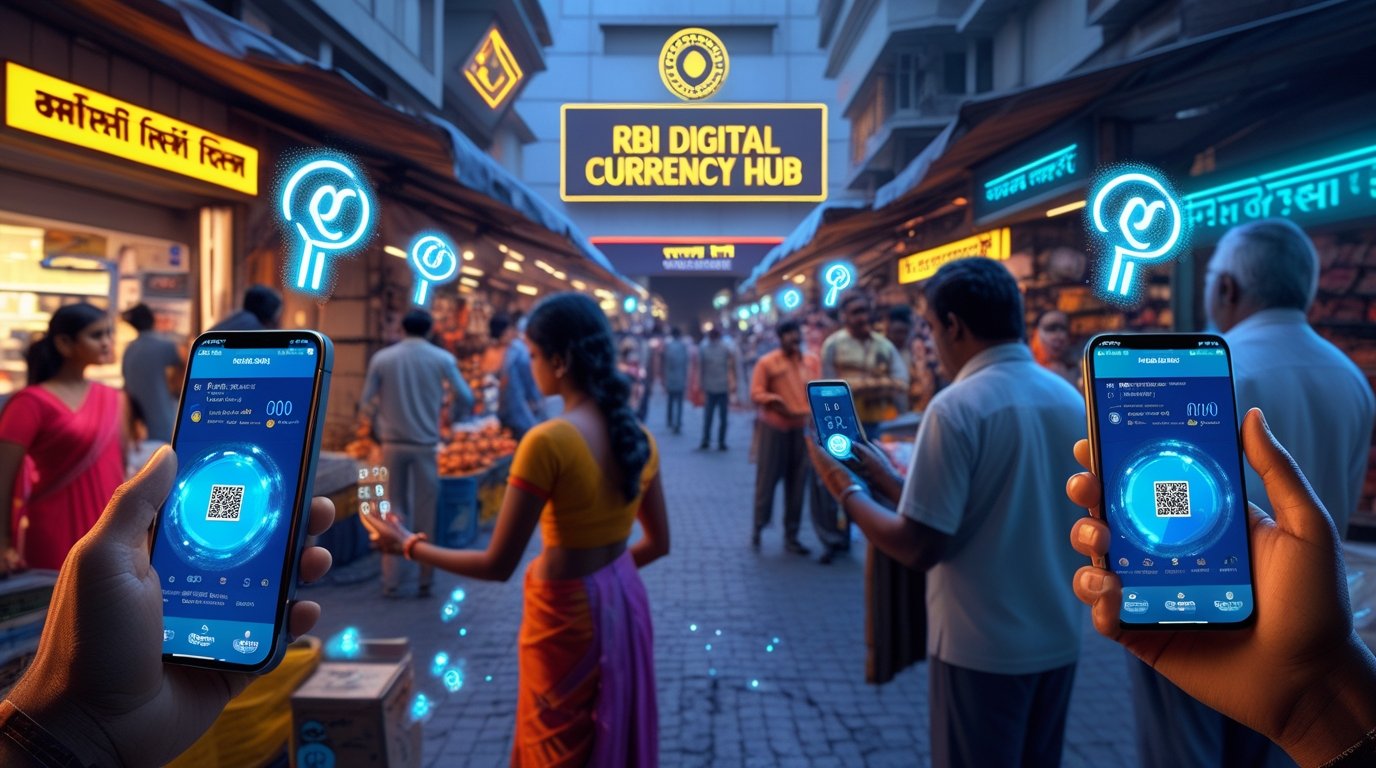Imagine paying for your morning coffee with a digital currency issued by your country’s central bank, instantly and securely, without cash or cards. Central Bank Digital Currencies (CBDCs) are transforming how we spend, save, and transact in 2025. But what does this mean for your daily life? Will CBDCs make spending easier, or do they come with hidden challenges? This article explores the impact of CBDCs on everyday spending, their benefits, risks, and how they’re reshaping financial habits worldwide. Let’s dive into this digital revolution and see what it means for you.
What Are Central Bank Digital Currencies (CBDCs)?
Central Bank Digital Currencies (CBDCs) are digital versions of a country’s fiat currency, issued and backed by its central bank. Unlike cryptocurrencies like Bitcoin, CBDCs are centralized, regulated, and tied to the national currency’s value (e.g., a digital rupee equals one physical rupee).
Key Features of CBDCs
- Government-Backed: Issued by central banks, ensuring trust and stability.
- Digital Transactions: Enable instant, secure payments via mobile apps or digital wallets.
- Programmable: Can be coded for specific uses, like welfare payments or tax refunds.
- Traceable: Transactions are recorded, reducing fraud and illegal activities.
- Accessible: Designed for broad use, including by unbanked populations.
Why CBDCs Matter for Everyday Spending
CBDCs aim to make transactions faster, cheaper, and more inclusive. In 2025, over 100 countries, including India, China, and the EU, are piloting or launching CBDCs, impacting how people shop, pay bills, and transfer money. For example, India’s Digital Rupee, launched by the Reserve Bank of India (RBI), is being tested for retail and wholesale transactions, promising seamless everyday payments.
Example: Priya, a 28-year-old teacher in Mumbai, uses the Digital Rupee via her smartphone to pay for groceries. The transaction is instant, fee-free, and doesn’t require a bank account, making it ideal for small vendors.
How CBDCs Impact Everyday Spending
CBDCs are changing the way we handle money in daily life. Here’s how they affect everyday spending:
1. Faster and Cheaper Transactions
CBDCs enable near-instant payments without intermediaries like banks or payment processors, reducing fees. This is a game-changer for small transactions, like buying street food or paying for public transport.
2. Increased Financial Inclusion
CBDCs can reach unbanked populations, as they only require a smartphone or basic digital wallet. In India, where 190 million people remain unbanked, the Digital Rupee could bring millions into the financial system.
3. Enhanced Security
With blockchain or similar technologies, CBDCs offer secure, traceable transactions, reducing cash-related theft or fraud. Central banks can monitor for suspicious activity, ensuring safer spending.
4. Programmable Payments
CBDCs can be programmed for specific purposes, like restricting use to essentials (e.g., food, healthcare). This could streamline government subsidies or employee benefits.
Case Study: In China, the Digital Yuan (e-CNY) has been piloted in cities like Shenzhen. Residents use it for everything from taxi fares to online shopping, with over 260 million users by 2024, according to the People’s Bank of China. The system’s low fees and accessibility have boosted local commerce.
Benefits and Risks of CBDCs for Everyday Spending
Benefits of CBDCs
- Convenience: Pay instantly via apps, no cash or cards needed.
- Lower Costs: Minimal or no transaction fees compared to card payments.
- Inclusivity: Empowers unbanked individuals with digital access.
- Transparency: Reduces black money and tax evasion through traceable transactions.
- Global Reach: Simplifies cross-border payments for travel or remittances.
Risks of CBDCs
- Privacy Concerns: Central banks can track transactions, raising surveillance fears.
- Digital Divide: Limited internet or smartphone access could exclude some users.
- Cybersecurity Risks: Hacks or system failures could disrupt access.
- Cash Displacement: Reduced cash use may challenge small businesses or rural areas.
| Criteria | CBDCs | Traditional Cash/Cards |
|---|---|---|
| Speed | Instant transactions | Varies (card processing delays) |
| Cost | Low or no fees | Fees for card or bank transactions |
| Accessibility | Smartphone-based, unbanked-friendly | Requires bank account or cash |
| Privacy | Traceable by central banks | Cash is anonymous, cards less so |
| Security | High (blockchain-based) | Risk of theft (cash) or fraud (cards) |
How to Use CBDCs for Everyday Spending
- Get a Digital Wallet: Download a central bank-approved app or use a compatible wallet (e.g., RBI’s Digital Rupee app).
- Link to Your Account: Connect to a bank account or load funds directly.
- Make Payments: Scan QR codes or use NFC for in-store or online purchases.
- Track Transactions: Monitor spending via the app for budgeting.
- Stay Secure: Use strong passwords and update apps regularly.
Tip: Check official central bank websites, like RBI or Federal Reserve, for updates on CBDC rollouts and approved wallets.
What’s New in CBDCs for 2025?
- Global Adoption: Over 100 countries are exploring CBDCs, with India’s Digital Rupee and China’s Digital Yuan leading retail pilots.
- Interoperability: Efforts to make CBDCs work across borders for seamless travel payments.
- Offline Transactions: New tech allows CBDC use without internet, aiding rural areas.
- Green Focus: Some CBDCs prioritize eco-friendly blockchain systems to reduce energy use.
Example: The Bahamas’ Sand Dollar, a fully launched CBDC, supports offline payments via prepaid cards, making it accessible for remote island communities in 2025.
FAQ Section
What are Central Bank Digital Currencies (CBDCs)?
Central Bank Digital Currencies (CBDCs) are digital versions of a country’s currency, issued by its central bank. They’re designed for secure, instant transactions via apps or wallets, offering benefits like low fees and financial inclusion. Unlike cryptocurrencies, CBDCs are regulated and tied to fiat value. For example, India’s Digital Rupee supports everyday spending, from groceries to bills. Check RBI for updates on availability.
How do CBDCs affect everyday spending?
CBDCs streamline everyday spending with fast, low-cost transactions. You can pay for coffee or utilities instantly via a digital wallet, without bank fees. They’re inclusive, helping unbanked individuals access digital payments. However, privacy concerns arise as transactions are traceable. To start, download a central bank-approved wallet and ensure your device is secure. Learn more at Bank for International Settlements.
Are CBDCs safe for daily use?
CBDCs use secure technologies like blockchain, making them safer than cash for everyday spending. Central banks monitor for fraud, but cybersecurity risks like hacking exist. To stay safe, use official apps, enable two-factor authentication, and avoid sharing wallet details. Check your central bank’s website (e.g., Federal Reserve) for security guidelines and updates on CBDC systems.
Can CBDCs replace cash entirely?
CBDCs could reduce cash use due to their convenience for everyday spending, but replacing cash entirely is unlikely in 2025. Rural areas and small vendors may still rely on cash due to limited internet access. CBDCs like the Digital Yuan coexist with cash in China. To prepare, try CBDC pilots via apps and provide feedback to improve accessibility.
Conclusion
Central Bank Digital Currencies (CBDCs) are revolutionizing everyday spending in 2025, offering faster, cheaper, and more inclusive transactions. From buying groceries to paying bills, CBDCs like India’s Digital Rupee simplify financial life while promoting transparency. However, privacy and digital access challenges require careful consideration. As CBDCs evolve, they promise to reshape how we spend and save. Explore your central bank’s CBDC pilot or share your thoughts in the comments below. Subscribe to our newsletter for the latest on digital currencies!
Suggested Visuals:
- An infographic comparing CBDCs vs. cash/cards.
- A video explaining CBDCs (e.g., from Bank for International Settlements).


1 thought on “The Impact of Digital Currencies Issued by Central Banks on Everyday Spending”